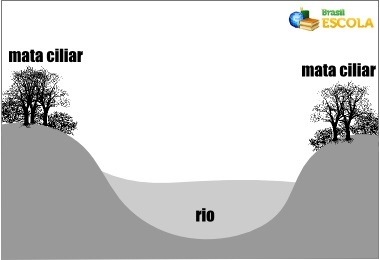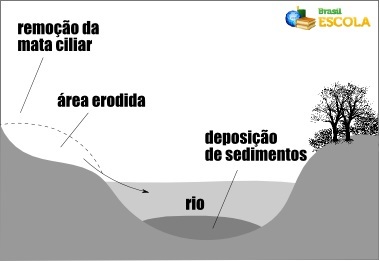silting it is the process in which watercourses are affected by the accumulation of sediment, which results in an excess of material on its bed and makes navigability and its use more difficult. Originally, this is a natural process, but it is intensified by human actions, especially after the removal of the riverbank vegetation.
The silting process usually occurs as follows: with rain, the soil is washed, that is, its surface layer is removed, and the sediments (soil and rock particles) are transported by runoff towards the rivers, where they are deposited. When there are no obstacles for these sediments, a function usually performed by vegetation, a large amount is deposited at the bottom of drainage networks.
This deposited material is taken by the river itself and, when it finds flatter places, where the speed of the watercourse it is not very accelerated, it deposits on the bottom, accumulating and eventually forming sandbanks along the watercourse. When the amount of sediment is very large and heavy, they are transported by rolling (on the bottom of rivers) or accumulate in the normal bed, causing damage to river flow.
When the human being removes the vegetation, mainly the riparian forest (the vegetation found on the banks of water courses), the above-mentioned process intensifies, in addition to generating the appearance of erosions in the vicinity of the river itself, as illustrated in the following images:

Scheme of an area under normal conditions, with little or no siltation

Scheme of a silted area, with sediment being deposited on the river bottom
Do not stop now... There's more after the advertising ;)
The consequences of silting up rivers and lakes can be directly felt by society. The rivers lose their ability to navigate, given that the sand banks that form hinder the passage of vessels, in addition to reducing the flow velocity. In addition, the water in these rivers, when encountering so many obstacles, deviates and can reach spaces where there were no watercourses before, including streets and houses, causing, therefore, floods urban areas.
Another factor is that when sediments mix with run-off water, the course of rivers becomes heavier and voluminous, which causes problems such as breaking the base of bridges or excessive flooding with local flooding next. Added to this is the loss of underwater vegetation and habitat conditions for fish and other animals, making it even difficult for the species to reproduce.
Silting becomes even worse when, in addition to sediments, garbage and sewage are deposited on the river, accumulating even more waste in its bed.
Example of a river with an advanced stage of silting, with the redefinition of its banks
To combat silting, the best measure is to work on its prevention, containing the erosive processes in areas located close to the drainages, in addition to imposing barriers so that sediments do not accumulate quickly over they. Cultivation and preservation of riparian forests are the most recommended measures, as they block the entry of sedimentary objects into rivers and conserve the soil on the banks, preventing river erosion.
__________________
* Image Credits: Ramon FVelasquez / Wikimedia Commons
By Rodolfo Alves Pena
Master in Geography
Would you like to reference this text in a school or academic work? Look:
PENA, Rodolfo F. Alves. "Silting of rivers"; Brazil School. Available in: https://brasilescola.uol.com.br/geografia/assoreamento-rios.htm. Accessed on June 27, 2021.

